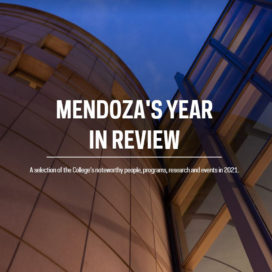Q & A with Barry Keating: Smarter forecasting, better profits
Published: November 3, 2009 / Author: Nancy Johnson

For businesses, it’s crucial to have accurate forecasts for product demand. When there’s an economic downturn that curbs orders, they risk big losses if they have too much inventory. Likewise, when a recession lifts and people want to buy, companies risk losses if they aren’t ready to meet higher demand. Clearly, it’s important to anticipate changes in the economy – but is that possible?
Yes, says Finance Professor Barry Keating at the Mendoza College of Business. A simple tool can reduce forecasting errors by up to 75 percent, according to his research, which is forthcoming in the Journal of Business Forecasting. He recently shared some thoughts on better forecasting.
Q. Why do companies need to predict changes in the economy?
A. In supply chain management, you need to get the forecast right at the very beginning of a turn in the economy. If you get that forecast wrong, or if that forecast has a high error, that error magnifies at each step back through the supply chain, causing significant cost increases. Product managers and others who do forecasting should be concerned with how to get rid of these errors, because errors mean either increasing inventories or they mean stock outs – units that you could have sold but didn’t. If there are errors on either side, you’re going to be hurt.
Q. What is causing these forecast errors?
A. In my paper, I cite work by Michael McCracken at the Philadelphia Federal Reserve. He found that forecast errors at the beginning of a recession are four times as high as when there’s no recession. The reason is that forecasters get very complacent over long periods when we don’t have a recession. They begin to use tools that don’t take into account where we are in the business cycle. They just assume – or they use tools that assume – that the business cycle we are in will continue. These are software tools that take the pattern it sees in the past and extrapolate it into the future. The problem is, what happens when the base model changes and you enter into a recession? No extrapolation model will ever forecast a downturn or an upturn. So the question is, how do you modify the tools we use in order to take into account a change of direction?
Q. How do you do that?
A. The key is to use the government’s leading economic indicators, which are prepared by The Conference Board and are available online (http://www.conference-board.org). The leading economic index is made up of 10 indicators such as manufacturers’ new orders, stock prices, and building permits. These indicators change direction before the economy does. If you watch them, you get a preview of what’s coming in the economy. It is not perfect, but the results are much better than not using it.
Q. Why don’t forecasters do this?
A. Unfortunately, every generation of forecasters has to relearn it. Over the seven or eight years or longer that you have an economic boom, you get out of the habit of thinking about this.
Q. How do you apply the economic indicators?
A. There are some sophisticated models we use in forecasting that always take into account the level of economic activity, usually by using the index of leading economic indicators and sometimes by using other types of variables. For example, the University of San Diego has a regional index of leading economic indicators specifically for the city of San Diego. There are also indicators by industry, such as the auto industry.
Q. Can you give an example of applying the economic indicators?
A. In my paper, I looked at jewelry sales, which are affected by recessions. If you start in 2000 and let the software use an extrapolation model, it doesn’t pick up at all what we know happened, which was a downturn in 2001. The model just kept predicting ever-increasing sales in jewelry. Over time, the errors get larger and larger and the supply chain is negatively affected. On the other hand, if you had used the composite index of leading economic indicators and made the adjustment that academic forecasters suggest you make for the cycle, you can bring down those errors by 67 to 75 percent.
Q. We’ve been talking about recessions. Why is it equally important to be poised for an economic upturn?
A. Take the example of auto sales. Last year, every automotive company in the United States lost money, with the exception of Subaru. Now carmakers have cut production at their plants: they’ve furloughed or laid off workers, and some have closed plants. But as we come out of a recession, people go back to buying automobiles. What if the economy takes an upturn and people suddenly go out to the dealerships, but the dealers have nothing to sell? The dealer sends a message to the local distributor, who sends a message to the factory, and you go back through the supply chain, but the factory isn’t geared up to make cars now. They’ve furloughed workers and they don’t have the required materials to increase production. Companies that forecast poorly are going to lose orders to firms that forecast more accurately. Stock outs cost money in exactly the same way that holding too much inventory costs money. In fact, you can do even worse coming out of the recession than you did going into the recession.
Q. What’s the lesson here?
A. In general, watch the index of leading economic indicators and read the explanation that the Conference Board gives for its use. For statistical forecasters, learn how to employ those indicators in your statistical models.
/news_and_events/news_articles/article/4595/q-amp-a-with-barry-keating-smarter-forecasting-better-profits




